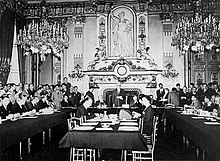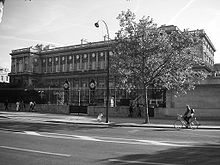Schuman Declaration: Difference between revisions
Robert1886 (talk | contribs) No edit summary |
Robert1886 (talk | contribs) No edit summary |
||
| Line 20: | Line 20: | ||
== References == |
== References == |
||
<div class="references-small"> |
<div class="references-small"> |
||
* {{ |
* {{Wikicite | reference=Schuman, Robert. Pour l'Europe. Paris 1963}} |
||
*{{wikicite | reference=Judt, Tony. ''Große Illusion Europa''. München: Hanser, 1994.}} |
|||
* {{wikicite | reference=McDougall, Walter. "Political Economy versus National Sovereignty: French Structures for German Economic Integration after Versailles." ''The Journal of Modern History'' 51, no. 1. (Mar., 1979): 4-23.}} |
* {{wikicite | reference=McDougall, Walter. "Political Economy versus National Sovereignty: French Structures for German Economic Integration after Versailles." ''The Journal of Modern History'' 51, no. 1. (Mar., 1979): 4-23.}} |
||
* {{wikicite | reference=Shore, Cris. "Inventing the 'People's Europe': Critical Approaches to European Community 'Cultural Policy.'" ''Man'' 28, no. 4. (Dec., 1993): 779-800.}} |
* {{wikicite | reference=Shore, Cris. "Inventing the 'People's Europe': Critical Approaches to European Community 'Cultural Policy.'" ''Man'' 28, no. 4. (Dec., 1993): 779-800.}} |
||
Revision as of 17:53, 18 June 2008
This article needs additional citations for verification. (October 2007) |

The Schuman Declaration is the name of the May 9, 1950 governmental proposal by Robert Schuman, French Foreign Minister, to place France's and West Germany's coal and steel industries under joint management. Schuman said the idea of the European Coal and Steel Community dated from the time before his going to university. Schuman initiated policies in preparation for this major change of European politics while Prime Minister of France (1947-8) and Foreign Minister from 1948 onwards. He spoke about the principles of sharing European resources in a supranational union at the signing of the Statute of the Council of Europe in London, 5 May 1949. The Declaration itself was first drafted by Paul Reuter, Schuman's colleague and the lawyer at the Foreign ministry and edited by Jean Monnet and others including Schuman's chef de Cabinet, Bernard Clappier. It became French government policy when after two Cabinet discussions it was agreed on 9 May 1950. The declaration's goal was for France, Italy, West Germany, and the Benelux countries to share strategic resources in order to 'make war not only unthinkable but materially impossible' and to build a lasting peace in Europe. The ultimate outcome of this initiative was the 18 April 1951 creation of the European Coal and Steel Community (ECSC), first of the European Communities and predecessor of the European Union.
Historical context
| History of the European Union |
|---|
 |
|
|
The Schuman Declaration marked the true beginning of post-World War II Franco-German cooperation and the re-integration of West Germany into Western Europe. Konrad Adenauer, Chancellor of West Germany, said of the declaration, "That's our breakthrough."[1]

The resulting ECSC introduced a common, single steel and coal market, with freely set market prices, and without import/export duties or subsidies. However, a transition period allowed the different economies to reach this situation over about one year.
In particular, the declaration specifies the creation of a High Authority, the forerunner of the European Commission, independent of the national governments. It also mentions the prospect of a European federation: "Europe will not be made all at once, or according to a single plan. It will be built through concrete achievements which first create a de facto solidarity."
On 18 April 1951, the leaders of the Six founder States of the European Community, (including Schuman) signed a European Declaration declaring that 'the signing of this Treaty ... marked the true foundation of an organised Europe.' In 1985, during a period when the president of the European Commission was a Frenchman, Jacques Delors, the Milan Summit of European Union leaders chose to commemorate the Schuman Declaration by making May 9 as the EC-sponsored Europe Day (the Council of Europe sponsored Europe day is May 5). The EC viewed the Declaration as the formative event of the European project: "the first Europe Day was celebrated on 9 May, the anniversary of the Schuman Declaration. The centenary of the birth of Jean Monnet, another of the founding fathers of Europe, which is being celebrated this year, is a similar affirmation of our common history."[2]
Notes
- ^ Judt (1994), 31.
- ^ Shore and Black (1992), 11. Shore (1993), 789 ff. 22 incorrectly dates the declaration to 1952, and conflates it with the Treaty of Paris, which though negotiated in 1951 came into effect in 1952.
References
- Schuman, Robert. Pour l'Europe. Paris 1963
- Judt, Tony. Große Illusion Europa. München: Hanser, 1994.
- McDougall, Walter. "Political Economy versus National Sovereignty: French Structures for German Economic Integration after Versailles." The Journal of Modern History 51, no. 1. (Mar., 1979): 4-23.
- Shore, Cris. "Inventing the 'People's Europe': Critical Approaches to European Community 'Cultural Policy.'" Man 28, no. 4. (Dec., 1993): 779-800.
- Shore, Cris and Annabel Black. "The European Communities and the Construction of Europe." Anthropology Today 8, no. 3. (Jun., 1992): 10-11.
External links
- EUROPA - Declaration of 9 May 1950
- http://www.schuman.info The initiator of Europe, Schuman or Monnet? Schuman's speeches and the Declaration in English with analysis.
- Video of the 9 May 1950 declaration (French) European NAvigator
- The 9th may's declaration : which past for an inheritance?, on "EUROS DU VILLAGE"
